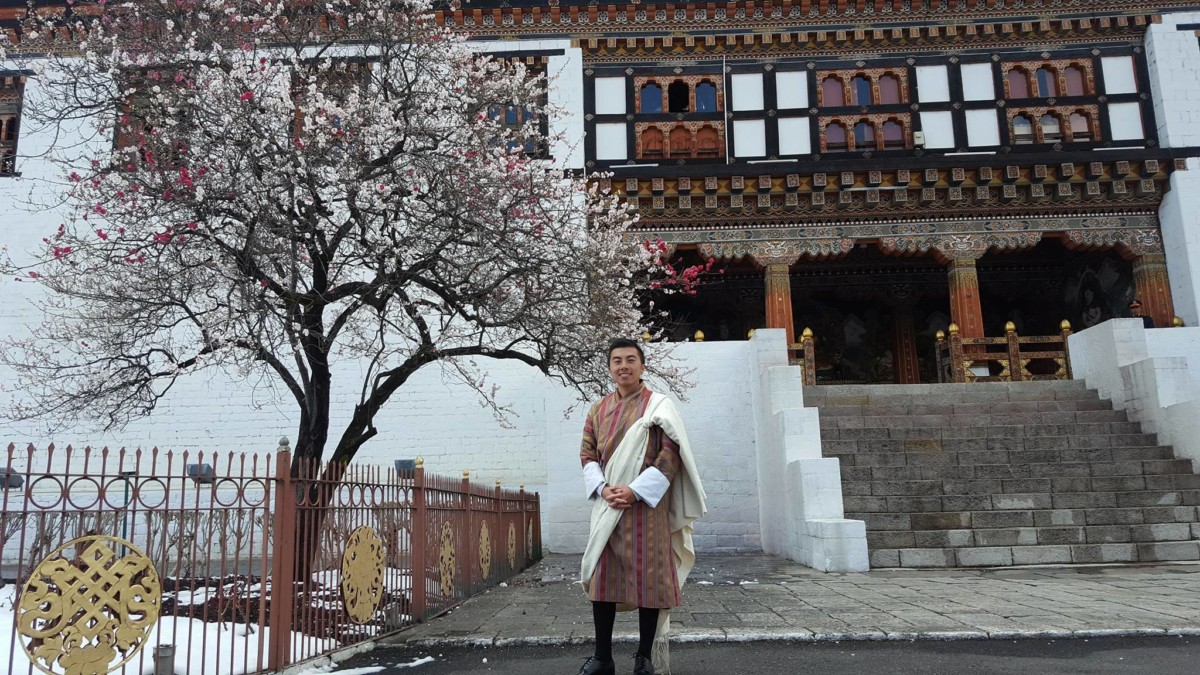This post is from student blogger Troy Wilkinson from Colorado State University, Journalism and Global Environmental Sustainability Major studying in Thimphu, Bhutan.
I wake up in a dark dorm room with the curtains defending me against the harsh morning light. I groggily get out of bed at 7:40 a.m. and don my gho. The gho is the men’s formal dress in Bhutan, the equivalent of a suit in most other countries. It’s almost like a robe. The colors and patterns vary depending on the situation’s formality or personal preference. A common pattern I’ve seen resembles checkered red and green pajamas, though many wear solid gray or striped orange ones as well.
Putting on a gho is a relatively complex process. It requires movements that, at first, uncomfortably twisted my arms. Initially, the garment hangs to floor and then, after ensuring that the sides are straight, lifting it up to form a skirt that hangs just below the knee. After that you’d tighten up the back of the gho and put on the belt, a colorful cloth that gets covered by pulling down the loose fabric around the chest.
It takes a little while to learn, but much less when you have as great a teacher such as my roommate Tshering. Tshering is usually still sleeping around 8 in the morning, so I’ve gotten extra tutoring so I don’t have to wake him up each day.
Once I’m wearing my gho I head to the mess hall, with its glorious rice and milk tea, the two menu items that are static for what I’m guessing will be the entire year. There are rare mornings when milk tea is switched out with butter tea, a distinctly Bhutanese drink that combines butter, milk and salt. The combination, by many standards, seems like it’d taste horrible. And that’s pretty true, but ever so slowly starts to grow on your taste buds (emphasis on “slowly”). I don’t care much for the rice, but I’m always excited to have morning milk tea. It’s essentially chai tea, simple, but lovely in the cold morning sun.
After about 10 minutes of chatting and drinking tea with other international students we are all off to Dzongkha class. My Dzongkha teacher couldn’t be more than a year or two older than me by my estimation. He and the two other tutors assist us in building our Dzongkha repertoire.
Kuzoozang po la! (Hello!)
Tashi Delek! (Best wishes!)
Nga gi ming Troy ‘ing. (My name is Troy.)
Chu gadebe u? (How are you?)
Now we’re stumbling through the Dzongkha alphabet, a process which is immediately confusing. We grasp at anything that could possibly relate the language back to English, but in reality Dzongkha utilizes sounds absent from the anything in my usual vocabulary. The sentence structure is different and the pronunciation of letters requires vocal techniques that only the throat can produce. I’m still struggling with saying the word “I” in Dzongkha, which is pronounced “nga” but used more nose and throat sounds than the tongue. I keep unintentionally saying “na” which means “here”.
At around 9:40 I head to Environmental Planning and Impact Assessment, taught by a Canadian man. He’s an energetic and enthusiastic bald man who continually attempts to draw participation out of the shy Bhutanese students. Rarely do I hear anything other than a “yes, sir” in my classes, even when the teacher is probing for a question.
Sustainable development and impact assessment seems to be a salient topic in Bhutan. The whole country, because of its adolescent stage in the developed world, is looking at hope to advance itself in technological and economic capability, while retaining tradition, culture, and the environment.
The classes last an hour here usually, so by 11:00 a.m. we’re released from the frigid classroom into reviving rays of sunlight. I walk up to the campus cafeteria with two other international students, Austin and Emily, to eat lunch. I talk to Joshin, one of the owners of the cafeteria and ask for a coffee, some momos, and egg chowmein. The meal totals to about a dollar-fifty in USD. All of us eat outside in the warm sun, our only escape from the frigid temperatures that fill the rest of evening.
Once it’s 1:30 p.m., my butt hits the chair in the back corner of room B23. I wait for my name to come during attendance and reply with a “yes, sir” like the rest of the Bhutanese students do. I don’t think my Dutch professor cares all too much about the formalities, but I do it anyway. This professor is a stern teacher, mainly because the some students in my class have a tendency to goof off. I appreciate the tough, no-BS style of teaching negation, a subject that requires toughness and confidence.
After negotiation I’m free to explore the Royal Thimphu College campus, take the bus down to Thimphu, or play football (soccer, not American football) on the large field next to the gymnasium. Sometimes I’ll choose to listen to music and play around on the slack line, which is set up right outside some faculty housing. Almost without fail, a couple us international students will find one another and head to a room to play cards or music. Eventually I hope to make use of the traditional archery grounds right next to campus.
The sun falls over the forested hillside and night floods the valley. It gets cold, really cold, and most everyone runs into their dorm rooms for warmth.
I laugh and relax with my roommate around our blaring space heater. He’ll often play some Bhutanese music and I’ll read in bed. Sometimes before bed I’ll request a lesson in Dzongkha, hoping to acquire a new phrase to use for tomorrow. I’ll repeat it over and over again right before Tshering switches off the lights.
“Chiru Delek, Chiru Delek, Chiru Delek…”






